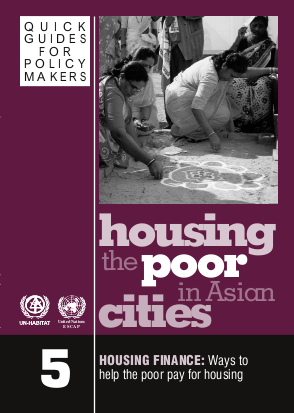
The objective of this Quick Guide is to introduce some of the key concepts of housing finance and to provide a quick overview of how housing finance works, especially as it relates — or fails to relate — to the urban poor. The guide presents information about both the formal and informal systems of delivering housing finance, and examines the key advantages and drawbacks of both systems when it comes to directing housing finance to the city’s poor.
The basic mechanisms of formal and informal housing finance systems may be similar, but by removing many of the barriers that make the formal system inaccessible to the poor, the informal system has in many places become the chief system for delivering what meager housing finance does actually reach the poor. The guide closes with a brief description of some new and unconventional housing finance strategies being tested and expanded in Asia, which are attempting to link formal sources of finance with poor communities and the informal systems by which they live their lives and build their housing.
This guide is not aimed at specialists, but instead aims to help build the capacities of national and local government officials and policy makers who need to quickly enhance their understanding of low-income housing issues.
Resource collections
- Prioritisation
- UN Habitat - Urban Response Collection
- Urban Response - Urban Crisis Preparedness and Risk Reduction
- Urban Response Collection - Community Engagement and Social Cohesion
- Urban Response Collection - Economic Recovery
- Urban Response Collection - Environment and Climate Change
- Urban Response Collection - Housing, Land and Property
- Urban Response Collection - Urban Crisis Response, Recovery and Reconstruction
- Urban Response Collection - Urban Resilience